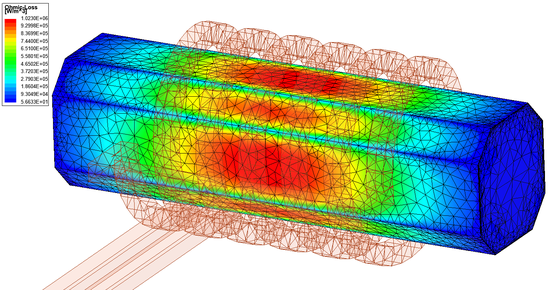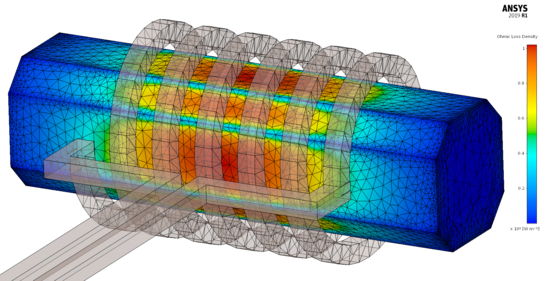Difference between revisions of "Lecture 2. - Assignment"
| Line 78: | Line 78: | ||
Az előző beállítások mellett még lehetőség van a nemlineáris maradékot (''Nonlinear Residual'') beállítani, de a példa esetében minden anyag lineár mágnesezési karakterisztikával rendelkezik. Ha szükséges itt lehet a direkt megoldó helyett bekapcsolni az iteratív megoldót, ahol szintén definiálni kell a leállási kritériumként szolgáló hibát (''Relative Residual''). Az adaptív hálósűrítés mellett, ennél a feladattípusnál lehetőség van magasabb fokú formafüggvények használatára (''Use higher order shape functions''), illetve ha szükséges a frekvenciasöprés (''Frequency Sweep'') tartományát és az ahhoz tartozó lépésközt. | Az előző beállítások mellett még lehetőség van a nemlineáris maradékot (''Nonlinear Residual'') beállítani, de a példa esetében minden anyag lineár mágnesezési karakterisztikával rendelkezik. Ha szükséges itt lehet a direkt megoldó helyett bekapcsolni az iteratív megoldót, ahol szintén definiálni kell a leállási kritériumként szolgáló hibát (''Relative Residual''). Az adaptív hálósűrítés mellett, ennél a feladattípusnál lehetőség van magasabb fokú formafüggvények használatára (''Use higher order shape functions''), illetve ha szükséges a frekvenciasöprés (''Frequency Sweep'') tartományát és az ahhoz tartozó lépésközt. | ||
| − | == | + | == Evaluation of results == |
| − | + | In addition to the variables (inductance, force) seen in the previous assignments, we can determine the losses in the iron or in the coil in this problem. These quantities can also be analysed as a function of frequency (''Frequency Sweep''). | |
| − | + | [https://www.ansys.com/products/electronics/ansys-maxwell ANSYS Maxwell] automatically calculates losses in the problem, but if we are curious about the eddy current loss in arbitrary part of the problem (e.g. in the cast iron rod), it should be calculate by 'Calculator' (Maxwell 3D <math>\to</math> Fields <math>\to</math> Calculator...). The eddy current loss can be calculated with the following relationship | |
::<math> P_{ö} = \frac{1}{2}\int_{V} \vec{J}\cdot\vec{E}^{*}\,\text{d}V = \int_{V} \frac{\vec{J}\cdot\vec{J}^{*}}{2\sigma}\,\text{d}V\quad[\text{W}]</math>. | ::<math> P_{ö} = \frac{1}{2}\int_{V} \vec{J}\cdot\vec{E}^{*}\,\text{d}V = \int_{V} \frac{\vec{J}\cdot\vec{J}^{*}}{2\sigma}\,\text{d}V\quad[\text{W}]</math>. | ||
| − | + | However, the following steps should be taken in the ''Calculator'' instead of the above equation | |
* Input <math>\to</math> Quantity <math>\to</math> OhmicLoss | * Input <math>\to</math> Quantity <math>\to</math> OhmicLoss | ||
| − | * Input <math>\to</math> Geometry <math>\to</math> '' | + | * Input <math>\to</math> Geometry <math>\to</math> ''Here we select the volume where we want to ccalculate the loss'' |
| − | * Scalar <math>\to</math> <math>\int</math> ('' | + | * Scalar <math>\to</math> <math>\int</math> (''Integral'') |
* Output <math>\to</math> Eval | * Output <math>\to</math> Eval | ||
| − | + | The spatial variables can also be plot in various forms, as illustrated by the following two figures. | |
{| width=100% | {| width=100% | ||
| Line 102: | Line 102: | ||
[[File:InductionHeating OhmicLoss.png|550px]] | [[File:InductionHeating OhmicLoss.png|550px]] | ||
|- | |- | ||
| − | |align=center | | + | |align=center | The streamlines of magnetic field intensity (''ANSYS Maxwell''). |
| − | |align=center | | + | |align=center | The eddy current loss on the surface of the cast iron rod (''ANSYS Maxwell''). |
|} | |} | ||
| − | + | The problem can also be solved with ''ANSYS Discovery AIM'' as shown in the following two figures. | |
{| width=100% | {| width=100% | ||
| Line 115: | Line 115: | ||
[[File:InductionHeating_OhmicLoss_DiscoveryAIM.png|550px]] | [[File:InductionHeating_OhmicLoss_DiscoveryAIM.png|550px]] | ||
|- | |- | ||
| − | |align=center | | + | |align=center | The magnetic field intensity in the cross-section of the problem (''ANSYS Discovery AIM''). |
| − | |align=center | | + | |align=center | The eddy current loss on the surface of the cast iron rod (''ANSYS Discovery AIM''). |
|} | |} | ||
== References == | == References == | ||
{{reflist}} | {{reflist}} | ||
Revision as of 09:21, 18 March 2019
|
Induction Heating | |
| Animated cut through diagram of a typical fuel injector.[1] | Animated cut through diagram of a typical fuel injector. [Click to see animation.] |
|
Instructor
|
Teaching Assistants:
|
Contents
Purpose of the Assignment
The student will learn the main steps of the finite element method, such as preparing the model (creating or importing geometry), specifying material parameters, boundary conditions and excitation through a time-harmonic simulation. Give a deeper understanding of the physical background of induction heating, melting and hardening.
Knowledge needed to solve the problem
- The steps of the finite element method;
- Theoretical knowledge of time-harmonic field (for defining materials, for excitation).
Steps to solve the problem
After launching ANSYS Electronics Desktop, select Project -> Insert Maxwell 3D Design from the menu.
It is also possible to solve the problem differently from the steps described below. To use ANSYS Maxwell, the Help menu and YouTube videos provide a lot of help.
Creating Geometry
In this case, we work with a pre-prepared geometry. This corresponds to the design of a geometry that a simulator engineer uses for numerical analysis of the device.
So the geometry is imported for this task. The geometry can be imported using the Modeler [math]\to[/math] Import ... menu.
Problem Settings
Defining Materials
In this exercise, the current carrying coil is copper, the iron is cast iron and the surrounding region of the coil and iron is air.
To define the air region, the Region is the simplest way, where
| + X Padding | -X Padding | + Y Padding | -Y Padding | + Z Padding | -Z Padding |
| 0% | 75% | 160% | 160% | 100% | 100% |
Specifying excitation
The excitation must be defined on the surface of the two terminals of the coil. The excitation is 50A, which must be defined on the surface of the coil terminals. When defining it, care must be taken to give the direction of excitation inward on one surface and outward on the other.
Mesh Settings
For the Eddy Current solution, the solver will use adaptive meshing. However, in cases where the eddy current may be significant, it is advisable to use the Skin Depth Based ... mesh operation on the surfaces where it is necessary.
I used this mesh on the surface of the cast iron rod, as shown in the figure. From ANSYS Maxwell 2019R1 version, the adaptive mesh does not change the resolution for those areas where Skin Depth Based ... mesh is defined. The purpose of this is faster convergence, but it is therefore important to define properly the resolution in the penetration depth.
A megoldó beállítása, a szimuláció futtatása
Ahogy a hálózási beállításoknál írtam, adaptívan sűríti a szükséges helyeken a megoldó a felbontást. Azonban az adaptív hálósűrítés paramétereit a megoldónál kell beállítani. Az adaptív lépések maximális száma (Maximum Number of Passes) legyen 10, a hibahatár (Percent Error) pedig 0,5%. A finomítás mértékét adaptív lépésenként (Refinement Per Pass) háromdimenziós feladat esetében célszerű az alapértékről (30%) lejjebb venni. Ez különösen akkor igaz, ha nincs előzetes információnk, hogy milyen módon konvergál, hogyan csökken a hiba a példa esetében. A finomítás mértéke 20% legyen. A megoldónál lehet a gerjesztés frekvenciáját (Adaptive Frequency) megadni, ennél a példánál [math]f = 500~\text{Hz}[/math].
Az előző beállítások mellett még lehetőség van a nemlineáris maradékot (Nonlinear Residual) beállítani, de a példa esetében minden anyag lineár mágnesezési karakterisztikával rendelkezik. Ha szükséges itt lehet a direkt megoldó helyett bekapcsolni az iteratív megoldót, ahol szintén definiálni kell a leállási kritériumként szolgáló hibát (Relative Residual). Az adaptív hálósűrítés mellett, ennél a feladattípusnál lehetőség van magasabb fokú formafüggvények használatára (Use higher order shape functions), illetve ha szükséges a frekvenciasöprés (Frequency Sweep) tartományát és az ahhoz tartozó lépésközt.
Evaluation of results
In addition to the variables (inductance, force) seen in the previous assignments, we can determine the losses in the iron or in the coil in this problem. These quantities can also be analysed as a function of frequency (Frequency Sweep).
ANSYS Maxwell automatically calculates losses in the problem, but if we are curious about the eddy current loss in arbitrary part of the problem (e.g. in the cast iron rod), it should be calculate by 'Calculator' (Maxwell 3D [math]\to[/math] Fields [math]\to[/math] Calculator...). The eddy current loss can be calculated with the following relationship
- [math] P_{ö} = \frac{1}{2}\int_{V} \vec{J}\cdot\vec{E}^{*}\,\text{d}V = \int_{V} \frac{\vec{J}\cdot\vec{J}^{*}}{2\sigma}\,\text{d}V\quad[\text{W}][/math].
However, the following steps should be taken in the Calculator instead of the above equation
- Input [math]\to[/math] Quantity [math]\to[/math] OhmicLoss
- Input [math]\to[/math] Geometry [math]\to[/math] Here we select the volume where we want to ccalculate the loss
- Scalar [math]\to[/math] [math]\int[/math] (Integral)
- Output [math]\to[/math] Eval
The spatial variables can also be plot in various forms, as illustrated by the following two figures.
| The streamlines of magnetic field intensity (ANSYS Maxwell). | The eddy current loss on the surface of the cast iron rod (ANSYS Maxwell). |
The problem can also be solved with ANSYS Discovery AIM as shown in the following two figures.
| The magnetic field intensity in the cross-section of the problem (ANSYS Discovery AIM). | The eddy current loss on the surface of the cast iron rod (ANSYS Discovery AIM). |
References






